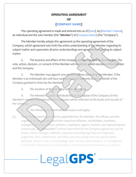What to Do When You Need to Fire a Problem Client
Every legal professional faces the uncomfortable reality at some point in their career: not every client relationship works out. Despite your best...
11 min read
LegalGPS : Jun. 16, 2025
It happens to the best of us. You're three weeks into a carefully planned project when your client sends that email: "Hey, we've been thinking... could we also add [insert significant new feature/deliverable/direction]?"


Legal GPS Pro
Protect your business with our complete legal subscription service, designed by top startup attorneys.
Your stomach drops. Your timeline flashes before your eyes. Your profit margin begins to evaporate.
Scope changes are the universal constant in client work—whether you're a freelancer, an agency, or a consultant. They're as inevitable as taxes and twice as disruptive. But here's the truth: how you handle scope change requests can make the difference between a project that spirals out of control and one that becomes even more profitable and successful than originally planned.
This guide will walk you through exactly what to do when a client wants to change the scope—from prevention strategies to implementation techniques—so you can turn these challenging moments into opportunities for both your business and your client relationships.
Before we dive into how to handle scope changes, let's get clear on what we're actually dealing with.
Common types of scope changes
Scope changes typically fall into a few categories:
Additions: "Could we also include X?" The client wants to add new features, deliverables, or services beyond what was originally agreed upon.
Pivots: "Actually, instead of X, we'd prefer Y." The client wants to change direction, sometimes substantially, from the original plan.
Expansions: "We love this! Could we apply the same approach to our other three products?" The client wants to extend the scope to cover more ground than initially planned.
Refinements: "We need to make this more [detailed/robust/comprehensive]." What might sound like a small tweak actually requires significant additional work.
Why clients request scope changes
Understanding the reasons behind scope changes can help you respond more effectively:
Distinguishing between scope creep and legitimate changes
Not all scope adjustments are created equal:
Scope creep happens incrementally—a small request here, a tiny addition there—until suddenly you're doing twice the work for the same pay. It's often unintentional on the client's part but devastating to your profitability.
Legitimate scope changes are conscious, acknowledged pivots or additions that respond to new information or circumstances. These can be healthy for the project when properly managed.
The key difference? With legitimate scope changes, everyone acknowledges that the change affects timeline, budget, or both. With scope creep, these impacts go unrecognized until it's too late.

Contract Addendum Template
Download our Contract Addendum Template to make modifications or additions to existing agreements. Customize it to fit your contract changes today!
Trusted by 1,000+ businesses to safeguard their LLCs.
The hidden costs of unmanaged scope changes
Scope changes affect more than just your timeline:
The good news? With the right approach, you can manage scope changes in a way that actually strengthens client relationships and improves profitability.
The best way to handle scope changes is to prepare for them before your project even begins.
Contract clauses that protect you
Your contract is your first line of defense:
A solid contract doesn't mean you'll refuse all scope changes—it simply ensures that when changes occur, there's a clear framework for handling them.
Setting expectations during onboarding
The client onboarding process is your opportunity to establish healthy patterns:
Creating a scope change process in advance
Develop a standard procedure for handling change requests:
Documenting the original scope clearly
Detailed initial documentation makes identifying scope changes much easier:
A formalized scope change protocol can transform potentially awkward conversations into smooth business operations. Here's how to create one that works:
Essential elements of an effective scope change protocol:
Start with a scope change request form that asks specific questions: What exactly is being requested? Why is this change needed? What business outcome will it achieve? Is this change time-sensitive? Include a clear evaluation process with defined steps: Initial review (usually within 24-48 hours), impact assessment on timeline and budget, and presentation of options to the client. Establish an approval hierarchy – who on both sides needs to sign off on changes at different budget thresholds? Create a documentation system that updates the master project scope after each approved change.
Introducing your protocol to clients:
Present your scope change process as a benefit to clients, not a bureaucratic hurdle. During onboarding, explain: "We have a streamlined process for handling changes that ensures we can be responsive while keeping your project on track." Keep the initial explanation simple but make detailed documentation available. Consider creating a one-page visual flowchart of how the process works. Reinforce the process by responding quickly to initial change requests with your standard protocol.
Sample Provision:
Here's a simple email template for responding to informal scope change requests:
"Thanks for sharing this idea for [briefly describe their request]. This would be a change to our current project scope, so I'll need to evaluate how it impacts our timeline and budget. To get this process started, could you please fill out our quick scope change request [form/document] by [specific date]? This helps us make sure we understand exactly what you're looking for and can provide accurate estimates for the additional work. I'll get back to you with an assessment within [timeframe, typically 2-3 business days] after receiving your completed form."
By implementing a consistent protocol, you transform scope changes from potential points of tension into straightforward business transactions that both parties understand and expect.
When a client requests a scope change, your evaluation process is crucial for maintaining profitability and relationship health.
Questions to ask when a change is requested
Start your evaluation with these key questions:
Assessing impact on timeline, budget, and resources
Be methodical in calculating the full impact:
Determining if the change is within your capabilities
Not all scope changes are created equal:


Legal GPS Pro
Protect your business with our complete legal subscription service, designed by top startup attorneys.
Deciding whether to accept the change
Sometimes the best response is "no" or "not now":
Remember, you're not obligated to accept every scope change request. Your evaluation should lead to one of several possible responses: accepting the change as requested, proposing a modified version, suggesting it as a separate project, or politely declining.
Here's how a web development agency successfully navigated a significant mid-project scope change:
The Situation: Three weeks into building an e-commerce site for a specialty food retailer, the client requested adding a subscription box service—a major feature not in the original scope. The initial reaction from the project team was panic, as this would require new functionality, payment processing changes, and inventory management integration.
The Approach: Instead of immediately saying "yes" (risking profitability) or "no" (risking the relationship), the agency followed their scope change protocol:
The Resolution: The client chose Option C, appreciating both the agency's flexibility and their transparent process. This resulted in:
The key to this success was presenting options rather than obstacles, while still maintaining appropriate boundaries around scope, timeline, and budget.
Once you've evaluated a scope change request, your response needs to be both professional and strategically sound.
Communication strategies that maintain relationships
How you deliver your response is almost as important as what you say:
Presenting alternatives when appropriate
Sometimes the best response isn't yes or no, but "what about this instead?":
Creating revised proposals and amendments
When you agree to a scope change, documentation is crucial:
Negotiation tactics for fair compensation
Scope changes should never mean working for free:
Remember, how you handle the negotiation sets expectations for future projects and changes. Stand firm on fair compensation for your expertise and time.
Once a scope change is approved, implementation requires careful management to maintain quality and relationships.
Updating project plans and documentation
Start with thorough documentation updates:
Communicating changes to team members
Ensure your team fully understands the implications:
Adjusting workflows and timelines
Practical adjustments are essential for successful implementation:
Maintaining quality while accommodating changes
Quality should never be sacrificed, even under revised constraints:
Proactive check-ins can catch potential scope issues before they become formal change requests. Here's how to implement this strategy effectively:
Structured check-ins that prevent surprises:
Schedule formal project review meetings at key milestones—not just to present work, but to confirm continued alignment with business goals. A simple but powerful question to ask: "Based on what you've seen so far, is this project still on track to meet your primary business objectives?" Create a standardized mid-project questionnaire that helps clients articulate emerging needs or concerns. Include specific questions like: "Is there anything about the current direction that doesn't feel quite right?" or "Have any business priorities shifted since we began?" For longer projects, implement a brief monthly "temperature check" call with key stakeholders that explicitly addresses scope satisfaction.
Techniques for identifying scope issues early:
Listen for "scope whispers"—casual comments that might signal underlying dissatisfaction or changing needs. These often appear as throwaway remarks like "I was thinking it might be nice if..." or "I recently saw a competitor doing..." Pay attention to new stakeholder involvement—when additional client team members suddenly join meetings or review processes, scope changes often follow. Look for approval hesitation—if a client who was previously decisive suddenly becomes tentative about approving work, they may be reconsidering aspects of the scope. Monitor external business changes for your clients, such as new product launches, organizational changes, or market shifts that might drive new requirements.
Realigning expectations mid-project:
When potential scope issues emerge, address them directly: "I noticed you mentioned X in our last call. It sounds like you might be thinking about adjusting our direction. Should we schedule a specific conversation about that?" Document and circulate key project decisions and confirmations after each milestone to create a shared reference point and prevent drift. Create visual representations of the current scope and progress to maintain clarity for all stakeholders. Consider creating a "parking lot" for good ideas that arise mid-project but don't fit the current scope—this acknowledges their value while maintaining focus.
By implementing these proactive check-in strategies, you can often address emerging scope concerns before they become formal change requests, creating a smoother project experience for everyone involved.
Scope changes are a reality in any client service business, but they don't have to derail your projects or erode your profitability. By implementing the strategies outlined in this guide, you can transform scope change requests from potential crises into opportunities for deeper client relationships and increased revenue.
Remember these key principles:
Perhaps most importantly, shift your mindset about scope changes. When handled properly, they aren't interruptions to your carefully planned project—they're opportunities to demonstrate your expertise, flexibility, and commitment to your client's evolving needs.
The most successful client relationships aren't the ones without scope changes; they're the ones where scope changes are handled so smoothly that they strengthen trust and lead to expanded work.
The biggest question now is, "Do you need a lawyer for your business?” For most businesses and in most cases, you don't need a lawyer to start your business. Instead, many business owners rely on Legal GPS Pro to help with legal issues.
Legal GPS Pro is your All-In-One Legal Toolkit for Businesses. Developed by top startup attorneys, Pro gives you access to 100+ expertly crafted templates including operating agreements, NDAs, and service agreements, and an interactive platform. All designed to protect your company and set it up for lasting success.

Legal GPS Pro
Protect your business with our complete legal subscription service, designed by top startup attorneys.
|
Premium Template
Single-use Template |
Legal GPS Pro
Unlimited Access, Best Value |
|
|
| Choose Template | Learn More |
| Trusted by 1000+ businesses | |

Every legal professional faces the uncomfortable reality at some point in their career: not every client relationship works out. Despite your best...

You’ve poured your heart into a project, sent a polished invoice, and waited for the payment that never arrives. Instead, you get excuses, silence,...

You’ve just delivered a $5,000 website redesign for a client, expecting payment within 30 days as agreed. Then, an email lands: they’re facing cash...